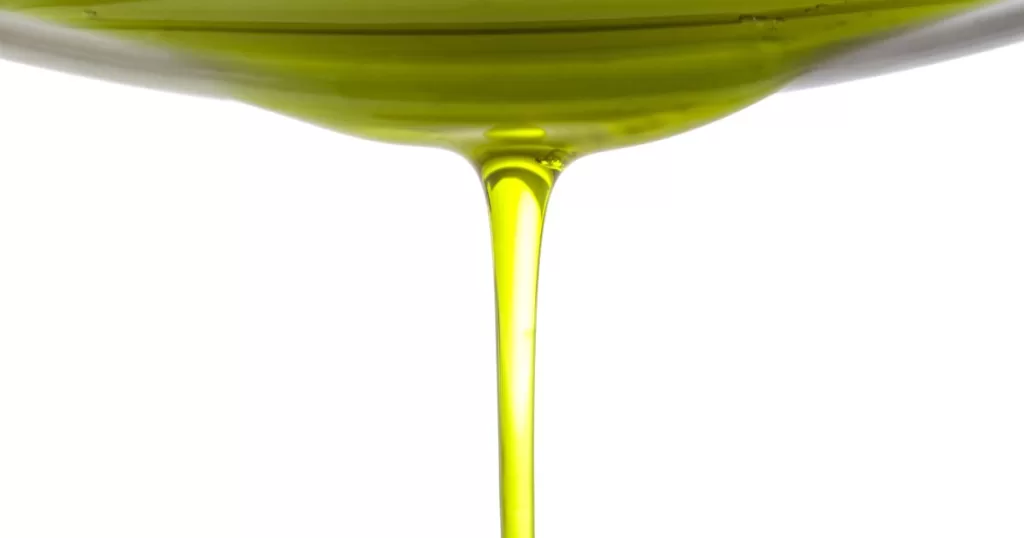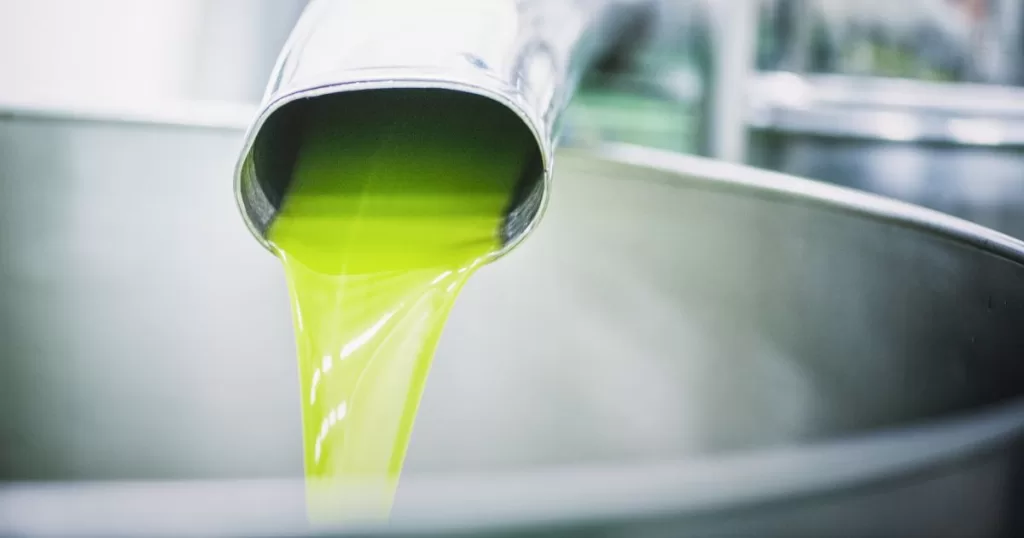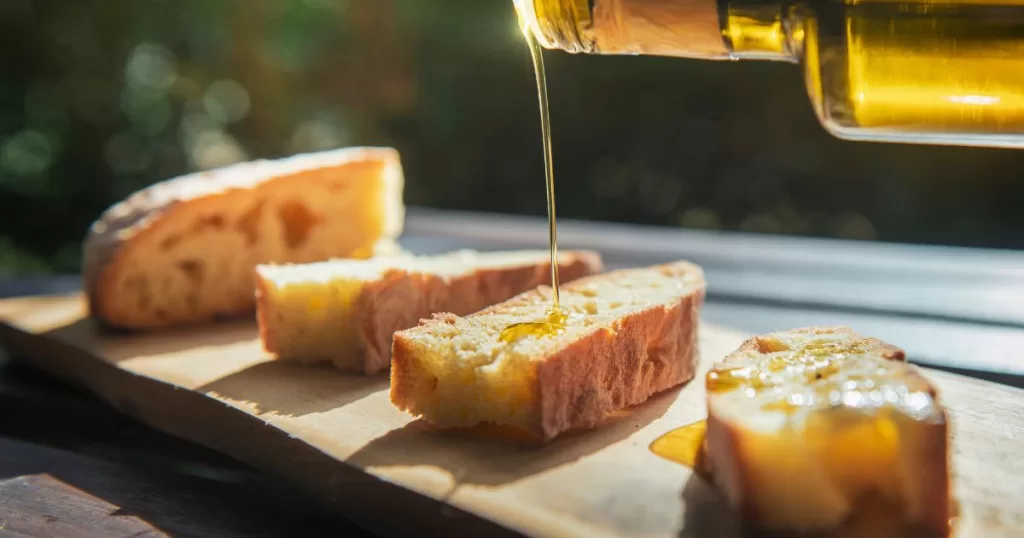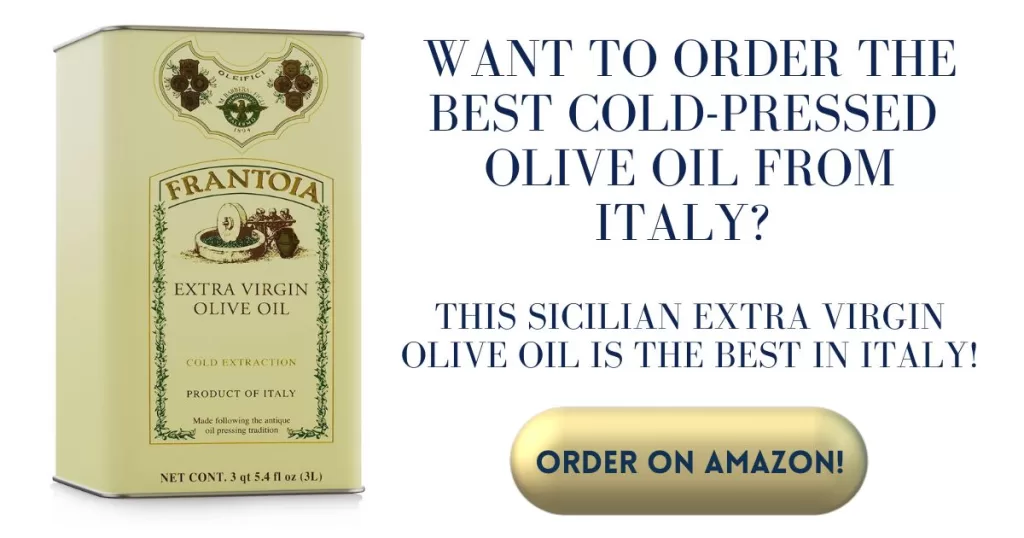
Cold Pressed Olive Oil vs Regular: Which Is Better?
Your Guide To The Complexities And Differences In The Olive Oil Industry And The Types Of Production Techniques

- Nathan Heinrich
- Rome, Italy
What is the difference between cold pressed olive oil vs regular olive oil?
How is cold-pressed olive oil made?
What is extra virgin olive oil?
How do you choose the best olive oil for cooking or using directly on food?
In this comprehensive guide, we will delve into the characteristics, production methods, and health advantages of olive oil.
We will also explain the difference between extra-virgin oil that is cold-pressed, from the highest grade olives, and cheaper poor-quality oil that often contains volatile compounds and additives.
Discovering Good Olive Oil In Italy
Before moving to Italy from the United States, I found the labels on olive oil to be very confusing.
I also had never actually tasted good, cold-pressed, extra virgin olive oil made in the traditional method – the way Italy and other Mediterranean countries have been making it for thousands of years.
Falling in love with good olive oil and its “peppery” bitterness has been one of the best things about my new life in Italy.
I am convinced that the high amount of unrefined olive oil that has been added to my diet is a major contributor to the dramatic improvement in my health since moving to the Mediterranean region.
READ MORE:
Table Of Contents
Why Olive Oil Is So Good For You
One of the main reasons for including cold-pressed extra virgin olive oil in your diet is because of its array of health benefits.
Rich in monounsaturated fats and antioxidants, cold-pressed olive oil has been associated with numerous advantages for heart health, inflammation reduction, and overall well-being.
The presence of phenolic compounds and vitamin E, found in cold-pressed olive oil, contributes to its antioxidant properties and helps combat free radicals while protecting the body’s cells from oxidative stress.

How Is Cold-Pressed Olive Oil Different From Regular Olive Oil?
Olive oil is derived from the fruit of olive trees (Olea europaea).
The extraction process involves pressing or crushing the olives to extract the oil from the olives.
While there are various types of olive oil, two prominent categories are cold-pressed extra virgin olive oil (EVOO) and “regular” olive oil.
Extra virgin olive oil is the highest quality and most flavorful, while regular olive oil is more refined and has a milder taste.
Now, let’s explore these types in more detail.

Cold-pressed olive oil refers to oil extracted solely through mechanical means, without the application of heat.
This gentle process ensures that the oil retains its natural flavors, aromas, and nutritional integrity.
The color of this fabulous oil is a vibrant chartreuse green, the aroma and flavor is vibrant and peppery.
Cold pressing involves crushing the olives, in their whole form, into a paste and then pressing the paste to extract the oil.
By avoiding high temperatures, the delicate compounds and volatile aromas of the olives are better preserved, contributing to a more vibrant and distinct flavor profile.
Cold-pressed olive oil is often also extra virgin olive oil which means that it is the oil obtained from the first pressing of the olives in a batch.
Sometimes the same batch of olives can be pressed 3 or more times, but with each press the quality of the oil drops.
The first cold press is where true extra virgin olive oil comes from – this is the finest oil you can buy.

"Regular" Olive Oil
Regular olive oil, also referred to as “pure olive oil” or just olive oil, is a blend of refined olive oil.
There are practically no regulations on this non-extra virgin oil.
This means you never really know what is in your oil, where it’s from, or if it really is olive oil.
The color of “regular” olive oil is more golden and the flavor is dull and tasteless.
The refining process involves treating the oil with heat and chemical solvents to remove impurities and neutralize intense flavors.
While this refining process may diminish some of the natural antioxidants and flavor characteristics, it results in a more stable oil with a higher smoke point.
Unfortunately the reason the “smoke point” is higher is because the oil has been infused with petroleum-based solvents and often blended with other non-olive oils.
Rapeseed, canola, sunflower, and safflower oils are commonly mixed into “regular” non-extra virgin olive oils without ever being listed on the labels.
If you are looking for good quality oil, look for a brand grown and produced in California.
California olive oil is considered some of the best-quality olive oil because the standards for production in California are high and strictly monitored.
Why Do Many Olive Oil Brands Use Misleading Labels?
Like many food labels in our modern world of fake food and imitation products, olive oil labels are intentionally misleading.
I was once under the impression that the $4 bottle of olive oil I usually bought with “all-natural” “extra virgin oil” stamped on the label was more or less the same as the more expensive bottles sitting on the shelf beside it.
The olive oil industry has been especially rife with corruption for the past 60+ years, and thousands of years before that.
In 2019, a story by 60 Minutes and an investigative report by The New Yorker magazine shed light on the dark world of counterfeit olive oil.
These stories reported that approximately 70% of extra virgin olive oil is likely fake or completely mislabelled.
A Confused Consumer Is More Vulnerable
There are many examples of misleading and blatantly dishonest labeling when it comes to the olive oil labels in our supermarkets and grocery stores.
The two videos above do an excellent job explaining olive oil fraud in graphic detail.
Here are some deceptive terms you should be wary of when shopping for olive oil.
"Bottled or Produced in Italy"
This claim is not enforced and the oil may or may not have been made in Italy or from Italian olives.
Read the back label for the fine print on the source of the oil. Very often the real source is Spain, Greece, or Tunisia.
"All Natural" or "Pure Olive Oil"
These are very vague and misleading terms that can refer to any combination of production methods.
It is also very common for this labeling claim to distract from the artificial and unhealthy ingredients used in the oil extraction process.
"Light Olive Oil"
This is essentially the same as “pure olive oil” but with a lighter flavor and color. But it is not lighter in calories nor is it actually healthier as this term suggests.
Read The Label For The Best Olive Oil From Italy And The Mediterranean Region
To ensure that you are getting the “real thing” check the back label very closely.
For Italian olive oil look for DOP on the label – this is oil from a specific protected and regulated growing region.
Also, look for a harvest date and the name of the specific town and region where the oil is produced.
If the label says the oil is a “product of Europe” or the “European Union” that’s a red flag and the oil is most likely fake.
Just claiming that oil is a product of Italy, Spain, or France is not enough.
You must have a harvest date, city, and region at the very least.
If you find the name of the specific farm or family that makes the oil you’re in great shape.
Also, expect to pay more for high-quality olive oil.
Olive oil production is a labor-intensive endeavor – the best and healthiest olive oil does not come at $4 a bottle.
Health Benefits Of Cold Pressed Extra Virgin Olive Oil?
Extra virgin olive oil is widely regarded as the pinnacle of olive oil quality in its purest form.
Although there are many different grades of olive oil, extra-virgin olive oil with its powerful antioxidants, vitamin K, and fatty acids, from fresh olives, is widely considered the best oil you can buy.
Buy your oil directly from a family-owned olive oil farm in Italy or California.
Extra virgin olive oil is characterized by its low acidity (typically below 0.8%), intense aroma, vibrant flavor, and high content of monounsaturated fats, particularly oleic acid.
Heart Healthy & Cancer Fighting
The health benefits of extra virgin olive oil are well-documented.
Its abundance of monounsaturated fats, combined with its natural antioxidants, makes it a heart-healthy choice.
Regular consumption of extra virgin olive oil has been linked to a reduced risk of heart disease, inflammation, and certain types of cancer.
Additionally, it has been associated with improved cognitive function, better weight management, and enhanced overall well-being.
The richness of polyphenols, vitamin E, and other bioactive compounds in extra virgin olive oil contributes to its potent antioxidant and anti-inflammatory properties.

Cooking & Culinary Applications: Cold Pressed vs Regular Olive Oil
When it comes to culinary applications, both cold pressed and regular olive oil have their respective uses.
Cold Pressed Olive Oil
Cold pressed olive oil, with its robust flavor and distinct characteristics, shines when used in dressings, dips, and drizzles.
Its fruity notes and intense aroma enhance the overall taste profile of dishes, particularly when used as a finishing oil.
Cold-pressed olive oil is best enjoyed in its raw form, allowing its unique qualities to take center stage.
Drizzle extra virgin cold-pressed oil over dishes before serving them or use it in salad dressings for the most robust flavor boost.
You can certainly cook with the highest quality oil from cold-pressed olives but cook at a lower temperature.
I personally use my superior quality cold pressed oil for every type of cooking here in Italy.
Regular Olive Oil
Regular olive oil, on the other hand, is a versatile cooking oil due to its milder flavor and higher smoke point.
It can be used for sautéing, frying, and baking, where a more subtle taste is desired without overpowering the other ingredients.
Regular olive oil serves as a suitable substitute for other cooking oils, providing a healthier option while still delivering the beneficial monounsaturated fats associated with olive oil.

Choosing the Right Olive Oil for Your Needs
When it comes to selecting the right olive oil, understanding the different types and grades available is essential.
Here are some key factors to consider when deciding between cold pressed olive oil vs regular olive oil:
Intended Use
Extra virgin olive oil shines in applications where its robust flavor and distinct aroma can be appreciated, such as drizzling over salads, dipping with bread, or finishing dishes.
Regular olive oil, with its milder taste and higher smoke point, is better suited for cooking methods that involve higher temperatures.
Flavor Profile
Extra virgin olive oil offers a spectrum of flavors, ranging from delicate and fruity to bold and peppery.
Regular olive oil has a more neutral taste.
Consider the flavor profile that aligns with your palate and the specific dish you are preparing.
Smoke Point
The smoke point refers to the temperature at which an oil begins to break down and smoke. Extra virgin olive oil has a lower smoke point compared to regular olive oil.
If you plan to cook at high temperatures, regular olive oil may be a more suitable choice to prevent the oil from reaching its smoke point and developing an unpleasant taste.
Quality and Authenticity
Look for reputable brands that adhere to high-quality standards and follow proper production methods.
Certification seals from organizations such as the International Olive Council can provide assurance of authenticity and quality.
By considering these factors, you can select the right type and grade of olive oil that complements your culinary needs and preferences.
READ MORE:

Recap
The distinction between cold pressed olive oil vs regular olive oil lies in their production methods.
Cold-pressed olive oil is extracted through a gentle mechanical process, preserving the natural flavors and health-promoting compounds of the olives.
There is no heat applied to the olives during cold-press oil extraction.
Cold-pressed oil offers a vibrant taste profile and is best enjoyed in raw applications.
On the other hand, regular olive oil undergoes a refining process and has a milder flavor.
While some feel that it is better for cooking, due to its high smoke point, I personally feel that it is best used as lamp oil or to quiet a creaky door.
When shopping for quality oil, be sure to check the label for harvest date, city, and region – California and Italian olive oil are excellent options.
Also, cheap oil is a red flag that it may be fake.
Whether you seek the robust and fruity flavors of cold pressed olive oil or the versatility of regular olive oil, incorporating high-quality olive oil into your diet can elevate your culinary experiences.
Olive Oil For A Good Life
You will reap the numerous health benefits associated with this “liquid gold” which originated from the Mediterranean region.
Are you interested in learning why Italians and people in the Mediterranean region are so healthy?
Click these links to learn how to cook like a real Italian and to understand the health benefits of the Italian diet vs the American diet.
READ MORE:

Disclosure:
Here at All Roads Lead To Italy, we only recommend products we would use ourselves and all opinions expressed here are our own.
This post may contain affiliate links with potential savings at no additional cost to you.
In some cases, we may earn a small commission.
Read our privacy policy for full details.


Dreaming of Moving to Italy?🇮🇹 - Get this FREE podcast & be INSPIRED by someone who moved from New York to Italy in 2020!
*By signing up for this Podcast you’ll also be joining our mailing list through which we will keep you up to date on all things Italian! We never sell your information and you can easily unsubscribe at any time.
Share This Post
Author Info:

Nathan Heinrich
Nathan is a writer, designer & horticulturist. He is the founder and Editor-in-Chief of "All Roads Lead to Italy" Magazine & host of the Top-10 Travel Podcast, "I'm Moving To Italy!". Nathan was born and raised in a 6th generation farming family in Northern California, he is currently, a dual Italian citizen, living in the Prosecco Valley of Northern Italy, near Venice.



